Tue 7 Jun 2011
Shoo!TAG: Patently Absurd
Posted by anaglyph under Gadgets, Hokum, Idiots, In The News, Science, ShooTag, Skeptical Thinking, Technology, WooWoo
[32] Comments
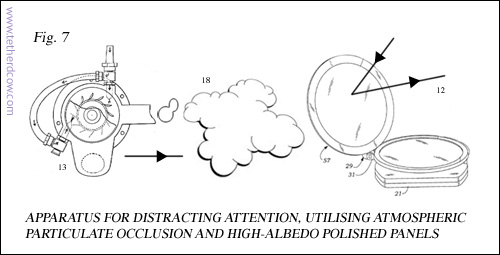
One of my favourite places on teh intertubes is the massive US Patent Database. You really could, if you were so inclined, spend an entire rainy afternoon traipsing down its digital corridors and uncovering all manner of bizarre, and sometimes clever ideas. Along with hundreds of thousands of approved patents, you can also find in these dim dark recesses, an enormous slush pile of hopeful patent applications – the wannabees and the has-beens of the entrepreneurial universe.
It has to be said, though, that whoever is in charge of the USPTO doesn’t make the traipsing easy. If you’re looking for something in particular the system seems to do its very best to evade any kind of sensible search procedure. If it was my job to sort it out, I’d approach the people who do the database programming for, oh, Amazon, for instance, and get them to look into a better system for the filing, archiving and retrieving of patents and applications. Because the USPTO sure needs one.
On the other hand, maybe the impenetrable and unfriendly process suits aspiring entrepreneurs quite well, if, let’s say, a punter like myself is in search of a… certain item of interest. It’s quite possible that secretive inventor types hope that the labyrinthine process will cause potential patent sleuths to give up before they can steal any precious ideas, or, as is my particular intention today, before they can bring them out of the musty digital recesses of patent database anonymity and into the bright light of rational public scrutiny. ((I want to point out that there is absolutely nothing illegal about doing this – US Patent Applications are publicly available to anyone who wants to see them.))
The item of interest I have in mind is this one: US Patent Application #20100243745 for an APPARATUS AND METHOD FOR REPELLING AN UNDESIRED SPECIES FROM A SUBJECT SPECIES. Its inventors are listed as: Heiney; Kathryn M.; (Wimberley, TX) ; Dubounet; Desire; (Budapest, HU); Rogers Melissa M.; (Austin, TX). The document was published on September 30, 2010.
Yes, that’s right. You have surely recognized it as the patent application for ShooTag. ((ShooTag is also now being promoted as ‘ShooBug‘. New name, same old woo.)) And just in case I need to draw a line under the name, the patent application for ShooTag is jointly owned by Melissa Rogers, Kathy Heiney, and Desiré Dubounet, aka ‘Professor’ William Nelson.
As you will recall, I have previously demonstrated indisputable links between Nelson and ShooTag, in my post ShooTag; Waterloo, despite Melissa Rogers’ & Kathy Heiney’s apparent efforts to erase any associations between themselves and Nelson and his crackpot notions. ((Nelson is nowhere mentioned on the ShooTag site at the time of this writing, although he featured very prominently on their ‘Science’ page when ShooTag first came to my attention. In addition, Google links to Heiney and Rogers’ attendance at one of Nelson’s QXCI conferences in Budapest have been rendered invalid and are only retrievable via Google’s cache.))
To recap, William Nelson was indicted in 1996 by the U.S. Food and Drug Administration on nine counts of felony fraud charges in relation to various ‘bioenergetic’ healing devices sold through his companies (these machines go variously under the names ‘QXCI’, ‘SCIO’, ‘EPFX’ and others, but they are all basically similar flavours of the same woo. They are implicated in the deaths of several people and the prolonged illnesses of many more). To evade prosecution, Nelson abandoned his home in the USA to take up residence in Budapest, Hungary, where he currently resides in the persona of Desiré Dubounet, and is still actively promoting his/her odd beliefs and his dangerous ‘medical’ machines. ((Where he claims, in the manner of so many charlatans of medical pseudoscience, to have fled because of persecution by ‘Big Pharma’. The reasoning presumably goes that his wonderful machines have solved all the medical problems known to humankind and if the word got out, the pharmaceutical companies would go bust, and they won’t let that happen by hook or by crook. Of course, when it comes down to concrete results, Nelson’s machines don’t deliver. They are at their most ‘effective’ on those maladies that have vague symptoms and subjective outcomes – just like all pseudoscientific medicine. The deaths attributed to these dangerous gadgets are mostly the result of critically ill people being hoodwinked into using them rather than seeking proper medical care. And, folks, in some cases you get so sick that you will die, no matter what anyone does. Modern medicine can’t cure everything, but it has a damn better chance than a silly box fuelled by ‘trivector frequencies’.))
The reason that Heiney & Rogers and their company, Energetic Solutions, don’t want any public association with him/her is, to most observers, pretty obvious I think. Nelson/Dubounet is a wanted criminal and an out-and-out fruitcake, and Energetic Solutions finds him/her and his flaky ideas a liability to the sales of its product. ((It’s probable that Heiney and Rogers aren’t able to determine that Nelson’s ideas are flaky, but I think that they, or perhaps their PR people, are keenly aware that a cross-dressing woo-spouting mad ‘scientist’ does tend to come across as a complete lunatic to most people. One has to assume that originally, in their addled ‘quantum-fractal-Schumann-Wave-bioenergetic-magnetic’ enthusiasm, Heiney and Rogers were all for Nelson’s mad ideas, but somewhere along the line they realised that maybe it was better that they just gave him his cut of the profits and kept him in the closet.))
Now I will emphasize strongly, as I have done before, that merely associating with a criminal does not make a person themselves a criminal. It is not William Nelson’s crimes that concern us here. We can, however, legitimately ask whether there is any link between Nelson/Dubounet’s pseudoscientific beliefs – beliefs that underpin her machines and the practices which have been found fraudulent by the FDA and the law – and the supposed basis for the working mechanism of ShooTag.
With that thought in mind, let’s take a look at some of the ShooTag patent application.
The first thing that probably doesn’t have to be said is that there is an encyclopaedic volume of utter crap in this document. It leaps, like a frog on LSD, from one crazy lilypad of gibberish to another. It is, in fact, a version of the ‘science’ that was originally expounded on the ShooTag website, and which has been subsequently removed (presumably because it made no sense to anyone who knew anything about science).
And we see immediately some of the trademark ideas of William Nelson: ‘cyclic voltammetry‘ and ‘trivector signatures‘. Nelson/Dubounet has expounded upon these ideas all over the web, and the ‘trivector’ concept is focal in the machines he sells. The patent application offers up a flow chart of how the inventors propose that ShooTag would work:
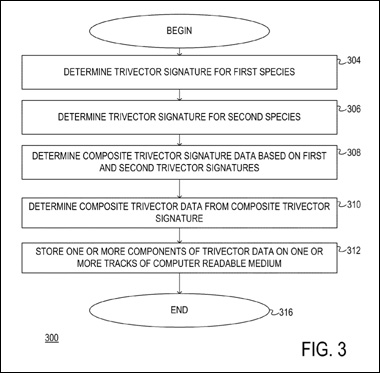
Already we are in pixie land. ‘Determine’ the trivector signature for the species concerned? Now how, exactly, should one go about doing that? Well, Fig. 4 throws some light on that question:
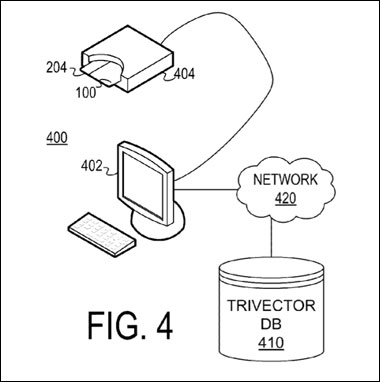
Aha! A network connection to a ‘trivector database‘. Now, I wonder where someone might find such a database? Plugging the term ‘william nelson trivector database‘ into a search engine returns hundreds of results related to Nelson’s QXCI/SCIO/EPFX machines just like this one:
What is the EPFX (Electro Physiological Feedback Xrroid) Quantum Biofeedback Device ?It is the most accurate and sensitive technology of its kind for identifying stress reactions to over 10,000 trivector voltametric algorithmic signatures stored in it’s ((Ah yes, unsurprisingly, these sites are a tour de force of bad grammar, spelling and punctuation.)) database, such as those taken from nutritional items, emotional imponderable formulas, allersodes, toxins and more.
And elsewhere, on William Nelson’s very own ‘Imune’ website:
•Every substance has its own unique trivector (voltammetric) field signature, and it seems that when a substance with a voltammetric field signature is introduced to the body, it can provoke a change in the field of the body.
•This voltammetric field has a virtual photon effect, which also influences the body and changes its electrical readings. Thus, the trivector signature of an organism will change when the trivector of a stimulus is introduced electrically via device. With this, Nelson realizes an innovation in electrophysiological reactivity (EPR) testing.
• A system is developed for recording thousands of 3-Dimensional trivector “shapes†of individual substances, such as organs, toxins, allergens, nutrients, and others
I think we can very reasonably infer that the ‘trivector database’ specified in the ShooTag patent application is the very same ‘trivector database’ referred to in connection with Nelson/Dubounet’s fraudulent machines. How that database is determined is impossible to know. We can be quite certain there is no published science that explains what these ‘trivector substance signatures’ are. In my opinion, the patent should be refused on that basis alone; even nonsensical homeopathy ‘treatments’ are at least available for public perusal.
My assessment is that the QXCI/EPFX/SCSI/ShooTag ‘trivector database’ is nothing more than a big heap of spurious numbers that have no real meaning whatsoever. Of course, I can be proved entirely wrong about that with the offering up of some properly presented scientific evidence. I have no fear, however, that any such evidence will ever come my way.
The patent application goes rambling on over four dense pages of ‘explanation’, often repeating much of the same daft silliness in different wording. It comes from the school of ‘If-you-don’t-have-facts-throw-in-lots-of-baffling-sounding-terms’ thesis writing. The whole lot could be simply summed up in one brief paragraph:
‘We have a card with a magnetic strip upon which is encoded some numbers. Via some completely unspecified mechanism, some of those numbers refer to insects, and some of those numbers refer to pets. Via some other completely unspecified mechanism, the numbers working together cause the insects to avoid the pets.’ ((You can make it even shorter, in fact: ‘It’s a magic card that keeps bugs away.’))
That’s it.
Of course, the ShooTaggers know full well that they’d never have even the remotest chance of getting a patent if they said it like that, hence the mind-numbing verbage and circumlocutious gobbledygook. One hopes that the patent examiners are so used to seeing this kind of thing that the red pen comes out well before the end of the first paragraph.
Elsewhere on the patent application, we find other enlightening information. To set the scene: you will remember that a little while back we comprehensively decoded the ShooTag data and exposed the silly magical thinking inherent in the information encoded on the card. Not long after that, ShooTag added a question to the FAQ on their site in an obvious (if risible) attempt to deflect this exposure: ((Presumably their thought process was that people would search for ShooTag, find our deconstruction of the data, and then be mollified by the pat explanation in the FAQ. Nice try, folks.))
How do I know if my tag is still working?
This is a fun one. We encode shoo!TAG® tags with a frequency embedded in the magstripe located on the back of the tag. Customers can take their shoo!TAG® to any retailer that carries a magstripe (credit card) reader and swipe it through. The type of tag (i.e. fly, mosquito, tick) will show up when scanned. If there is no name, then the shoo!TAG® tag has lost its efficacy.
Yeah, that really is a fun one because we’ve caught you with your trousers down again. Let me quote you from your very own patent application (and it’s said not once, but three times, in different places):
…the trivector data stored on the three tracks is not readable by a conventional credit card reader.
Indeed. That statement tallies perfectly with my own experience: swiping a brand new ‘Tick’ card in a conventional card reader at my local shopping centre merely resulted in a ‘Card Read Error’. Maybe the ShooTaggers will want to amend that FAQ again, to erase this little untruth as well. Of course, this circumstance suits them down to the ground – if any ShooTag card is swiped, it will always come up as non-functioning (as it always literally is, I might point out). This is a ruse quite plainly intended to persuade unsuspecting customers to buy another one. Make no mistake, these people never miss a trick when money is involved.
So, what are we to make of this attempt by Energetic Solutions to obtain a patent? It’s not like they need it for any particular legitimate reason. The patent process exists in order to invest the intellectual property rights ownership of an invention with legal protection, so that someone else can’t take a good idea and just steal it. But here’s the thing – how do you protect an ‘invention’ that has no rational basis for doing what is claimed? ShooTag says their invention uses ‘trivector frequencies’ to achieve its stated purpose, so even if they had a proper patent, there would be nothing at all to stop me from creating a similar pet tag that uses a different method of operation to repel fleas, such as, oh, ‘overmodulated photonic recursion’ or something. When you just make shit up, holding a patent for it has no meaning.
But.
If your aim is to try and get authentic sounding endorsement for a product that can’t get any legitimacy via the path of factual evidence, then holding a patent is certainly a good PR tool. In other words, if you haven’t got any science to back up your claims, hoodwinking an official body into giving you an official seal of approval will undoubtedly buy you some mileage. ((It strikes me also that these people are prepared to put in a huge amount of time, effort, and, one assumes, money to try and establish their patent. Is it not a telling indication of how they view their product that they aren’t prepared to put the same kind of commitment into proper scientific trials? And wouldn’t you think you’d do the scientific investigation first? All legitimate product development happens that way round…))
I think most people trust that an organization such as the US Patent Office scrutinizes a document like the ShooTag application and files it where it belongs – under ‘N’ for ‘Nonsense’. Sadly, that trust would be misplaced. The USPTO rubber stamps some pretty stupid stuff. Take Patent #5,603,915 ‘Process for manufacturing homeopathic medicines’. Its inventors are listed as Carmel Kiely and a certain William Nelson. This ‘invention’ basically calls for the application of an electric current to a homeopathic medicine solution to ‘increase its efficacy’. Its rationale goes on for seven pages of ridiculous garbage.
And folks, the US Patent Office saw fit to award it a patent in 1997.
This enables William Nelson to boast, as he does whenever given the opportunity, about the many patents he holds. For people who don’t know better, it will undoubtedly sound impressive. This, I propose, is the sole reason that Energetic Solutions desires their patent for ShooTag. Not to protect its ‘clever technology’, but simply so they can use it as another advertisement. It’s exactly the same ploy that they’ve used with the ‘scientific experiment‘ that they tout on their website.
When you don’t have actual facts on your side, all you’ve got to play with is smoke and mirrors, and man, do these people know ALL the tricks.
Still, if they do get their patent approved, we will have something to look forward to. Melissa Rogers promised us that:
When we go from patent pending to full patent protection, then all of our sceince (all three applications) will be disclosed.
Well, Ms Rogers, such is my confidence of that ever happening that I’m applying for a patent to cover the event:
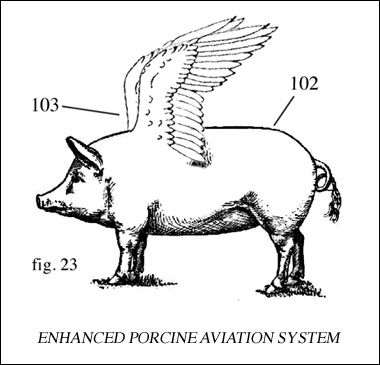
32 Responses to “ Shoo!TAG: Patently Absurd ”
Trackbacks & Pingbacks:
-
[…] I realised this morning that I’ve actually examined CieAura in the past. In the comments on this post, Brian J visits the Cow to tell us about his experience with them. He found his way here because […]
-
[…] model of a pyramid scheme.(iii) In the post before last, I mentioned Brian J, who left a comment on one of the ShooTag articles way back in June 2011. This is what he […]

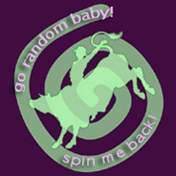


Nice sleuthing Rev
Thanks chief!
I won’t be holding my breath for that patent approval…
Nice work Rev.
The King
We’ll be calling you Detective Inspector Anaglyph after all this work. Can we assume then that you have forwarded all of your findings to the US Patent Office? Would they even care? We can always hope so.
I was at a presentation last night by a company named CieAura. They use the same technology as the shootag (so they say) and I was wondering what you have heard about them? They claim $80 million in sales this year and say that they will double next year.
I was thinking of become a distributor with them, but like I said, since they claim thier metod is the same as shootag, I was wondering what you thought?
I tried thier product and it really worked, but that was in the meeting.
Hi Brian, and welcome to the Cow.
First off, I just want to reply to you about something you said before I go off and investigate CieAura (whose very name waves a red flag).
You say:
“I tried thier product and it really worked”
Without even knowing anything about them, I’m going to take a punt and say that they persuaded you that ‘it really worked’ by doing some kind of ‘balance’ demonstration with you. Am I right? They made you stand on one leg and got you to hold the product and showed you how much ‘stronger’ you were when it was in your possession?
If so, this is a common and very easily exposed trick. I have done the same trick at parties demonstrating the uncanny power of a champagne cork.
You are right to be suspicious. I’ll go and have a look at CieAura and let you know what I think.
Okay, this is embarrassing. That is exactly what they did. They had me stand and they pulled my arm down to the left and then do it again wearing the “chip.”
There were several people there who were using the product for pain and testified to great results.
I have been using the sinus chip and my sinueses have been better. Maybe its just a placebo effect, I’m not sure.
But since the hologrpahic frequency stuff they described is the same as the shootag stuff here, this is why I wanted to check.
OK, I’ve looked through the CieAura website and I can tell you without any doubt that it’s a crock of shit. Their ‘science’ is risible, and is full of hocus pocus. Here are some bullshit phrases:
‘CieAura and its partner, HarmonicFM, have devised a way to imprint holographic chips with “Intrinsic Energies”‘
What does that even mean?
‘Different technologies for embedding the signals were needed, and HarmonicFM has successfully developed these technologies. The exact methods are proprietary.’
Of course they are. (In other words, ‘We can’t tell you how it works, but trust us, it does’)
‘First, the formula, once embedded into the chip cannot be modified, only erased (a strong magnet will do that)’
Erm… but it’s a holograph. Holographs are light refraction matrixes. They have nothing to do with magnets.
There are so many of these stupid pieces of hogwash it would take me pages to go through them.
The real howlers in the science though come in the form of the linked ‘studies’. The supposed double blind studies have absolutely NO references. Studies by whom? CieAura? Supervised by which third party? Let me just reword what CieAura should have written on their site:
‘We did some studies and they show that our product worked. Here are some numbers of people that it worked on. We called our tests ‘double blind’ because we often hear skeptical people speaking of such things and we figure that if we write it on our web page it will fool some people into thinking we did science’
The CieAura ‘Medical Board’ is equally risible as any kind of proper authority. All the people featured on the board are either simply MDs or, horrifyingly, chiropractors. What they say about the product does not amount to any kind of science – it is just vague personal endorsement.
Brian, CieAura is just another in a long line of snake oil remedies. If you become a distributor for them, you might make some money. But you’ll be doing it by ripping off people, usually poor people, and taking advantage of their lack of scientific knowledge. It’s your call, but personally, I couldn’t sleep at night.
Okay, thanks for responding. I am not going to move forward with this as you have definately proven your case.
But I must say I am very curious how this can happen? How do they get so many sales and people to use the product?
You are right that I “fell” for the old balance trick. But the trught is, I am very curious now exactly what they do. And I am sure you are as well.
Keep me posted on what you find out on them and thier “technology” (I put that in quotes as it appears there is none!
Thanks again!
OK, well, the first thing I’m going to say is that you’re well on your way to understanding what’s going on here simply because you’re looking at this with an appropriate amount of skepticism. You thought something was ‘fishy’ and then you did something that everyone could do well to learn from: you did some research and you asked questions.
Onto the balance trick – this has been around for decades. I first saw it performed when I was a teenager in the 1970s, in respect to ‘how bad sugar is for you’. A chap was giving a talk at a local college (I can no longer remember his agenda) and he asked for a volunteer from the audience. He stood the guy on one leg and showed how he was normally ‘strong’ and could easily maintain his balance (this was done in reverse to the way it would have been done in your case). Then, the volunteer was given a sugar cube to dissolve in his mouth. Of course, now he was suddenly ‘weak’ and could be unbalanced easily because of that bad ol’ sugar.
It was an impressive stunt and I was taken in. Until some years later I saw exactly the same routine applied to something else. I began to detect that slight whiff of fishiness too.
It turns out that this is a very simple trick and has to do with how you maintain your centre of gravity when you balance. Richard Saunders, of the Australian Skeptics, explains it very well in this YouTube video:
http://www.youtube.com/watch?v=r1ulmXdteSs
It seems so obvious that no-one would fall for it, right?
Now you should be aware that the people who do this trick have gotten very good at it, so most people are completely unaware that this is what’s going on. Usually, though, when it has been pointed out to you, you will never fall for it again, because you can feel instantly what’s happening.
If you doubt me at all, just have a look at some of the other videos on YouTube claiming to be using ‘applied kinesiology’ to test for countless ailments. What is more believable: that this diagnostic tool has been ignored by doctors everywhere (which requires you build a conspiracy theory about modern medicine) or that it’s a simple party trick? If you’re still in doubt, without telling them, try it on a friend and spin some yarn about sugar, or a magic pendant, or just use red and blue colours – demonstrating how red makes you strong and blue makes you weak or something (my wife saw exactly this recently on a ‘colour theory’ video for students). You will be amazed at how easily your subject is duped.
I will now go onto the claims of pain relief and your sinuses. The first thing to be understood here is that we don’t know everything about pain. I don’t know a single doctor who would tell you differently. There is, of course, the mysterious placebo effect, and we do know that, for some reason, the human brain is able to somehow control pain if it is tricked into doing so. A lot of research is being done into the placebo effect, and though we know it has real results, it still remains poorly understood.
But I would like to suggest that in the case of the people experiencing pain relief in the CieAura audience, and in the case of your sinuses, it’s rather a different phenomenon in effect, and one that is crucial to the success of gadgets like CieAura and so many other pseudoscientific beliefs. And it is simply: subjectivity. It has been demonstrated time and time again that humans are very poor observers. Before we go on, I’d like you to look at this video:
http://www.youtube.com/watch?v=voAntzB7EwE
Don’t be embarrassed that you fell for it. Everyone does. It demonstrates vividly the capacity for your brain to make mistakes. I suggest that the pain relief effect that the people with the CieAura pendants are experiencing is nothing more than their inability to make accurate comparisons between levels of pain. And it may be that there is some placebo effect in operation as well. As far as your sinuses are concerned, I suggest that you are concentrating on them rather harder than normally, that you want a solution and that your observations of change in your condition are highly subjective. What I can tell you for certain is that the CieAura has not cured your problem, nor made such a big difference that it is remarkable, right? It’s like all such beliefs: maybe you feel a little better… maybe if you gave it a bit more time…?
Gadgets like CieAura and ShooTag and QLink are all banking on the fact that the things they claim to do are difficult to quantify: do you feel like you’ve got more energy? Are there fewer fleas on your dog? Has your golf swing improved just a little? These are results that can all be the subject of flexible interpretation.
And that, my friend, is how pseudoscience works. These people are spinning tricks and vagaries and personal subjectivity into -what did you tell me? 80 million dollars in sales? At the expense of sick people? They should be truly ashamed.
The video was awesome. I guess you don’t know what you don’t know.
And by the way, thanks for not making me feel bad. Your response was very kind. I know I am from a smaller town in Missouri, but when you look at the evidence as you have presented it, you feel like you should have known better.
To sign up for their program was about a minimum $500 purchase, so I am REALLY glad I did not do it now.
My wife even said that perhaps the weather is just better and that is why my sinuses were good.
I am not trying to pick on anyone, but your idea of this being pseudoscience is interesting. You should get your own show on TV like Mythbusters. I would bet there is a lot of people out there who would like to know more about CieAura and QLink? (I never heard of them and based on everything else, don’t need to!)
Brian, it is for people like you that I write my critiques. Of course I wouldn’t make you feel bad – you came with an open mind in the spirit of seeking information. Every person like you that I equip with a little more critical thinking capability is a win over the forces of greed and charlatanism as far I’m concerned.
Don’t feel bad about being hoodwinked by these people. They’re very good at it. They have lots of practice. One thing I will point out (in case you didn’t already figure it out) is that they know they are swindling you. It’s impossible to do the balance trick on someone without knowing what you’re doing. However the CieAura people justify it in their own minds (giving them the benefit of the doubt, which I’m not sure I should), they essentially trick you into giving them that first 500 bucks. That’s a scam by any reckoning. And for many people, admitting to themselves they have been tricked after that point is too embarrassing, so they continue to convince themselves that ‘there’s something to it’ purely to save face.
As far as having my own TV show is concerned, well, hey, I’d be very happy to do that! Unfortunately, skepticism has been shown to be very bad tv. People don’t want us ‘party poopers’ telling them that their nutty ideas have no merit. The Mythbusters are the exception that proves the rule. They hit on something that was a fantastic (and very visual) idea. And Adam Savage is the first to suggest that people love to watch a show where there is the possibility of something blowing up. I guess in the Tetherd Cow Ahead Show, I could blow up the scam gadget in question at the end of each segment. I know it would certainly make me feel a lot better.
If you want info about these kinds of things on the web, your first stop should always be The Skeptics Dictionary:
http://www.skepdic.com/
I see they do cover QLink, although CieAura (which seems relatively new) is not there. It is a depressing fact that these kinds of scams are so numerous that it’s almost impossible to keep abreast of them.
Also, I’m curious brain/Brian: did the CieAura people actually boast that their product worked in the same way as ShooTag? Did they actually make that direct comparison?
Yes, if I could spell my own name right, I probably would have kept my balance!
To your question, it was a question from someone in the group who uses the product. They did not make the comparison as part of their formal presentation, but they did answer the question and made the comparison there. Which was good for me because that is how I found you.
Since starting my conversation with you, I have been looking for sites that refute CieAura and am surprised there are not more. The ones there are are not scientific like yours – they are just people ranting. Not much help.
But I am convinced anyway, so the search was just out of curiosty.
Thanks!
Interesting. I will look further into CieAura, so stop by on occasion and we’ll see what we can find out.
Wow! CieAura is good. Thay can actually put a homeopathic remedy onto a chip. And here I was thinking that water and electronics should never be mixed together. Silly me. That’s about the point that I stopped reading their site.
I have in my paw, after shelling out an eye-watering £27.01, a mosquito shootag.
I haven’t opened it.
Frankly, I’m scared. What should I do? Should I open it and read it? Or should I burn it before the woo infects me and I start selling pixels on the internet?
Wait, that already IS essentially my job. Um. Well anyway.
I also need to find out what the Texan version of the office of fair trading is, how to contact them, and how to lodge a complaint.
https://www.ftccomplaintassistant.gov/ looks a good place to start.
Or http://www.econsumer.gov/ for people outside the US.
I’ve submitted the following:
The product claims efficacy as a pesticide against ticks, fleas, or mosquitoes, citing EPA Est No 087374-TX-001.
The product is a magnetic strip, with three numbers encoded on it, which they call a “trivector”… but cannot read magnetic strips; and even if they could, they cannot read the decimally-encoded 7-bit ASCII numbers thereon; and even if they were so educated, they cannot be expected to know that those three numbers were the ones selected to mean “please keep away from the person on who’s belt loop this strip is attached”. In fact, while biting your arm, a mosquito will not typically be close enough to even see that you have such a card on you belt loop, let alone be close enough to swipe it, even if it carried a little card-reader wherever it went. So, OK, ineffective but harmless, right?
But medical devices that claim to operate using the pseudoscience of trivectors have already been banned from sale in the US. In fact William Nelson, one of the holders of the patent for shoo-tag, has had to flee to Budapest, due to nine counts of felony fraud charges in relation to various “trivector” healing devices sold through his companies.
Patent:
http://appft1.uspto.gov/netacgi/nph-Parser?d=PG01&p=1&u=.&r=1&f=G&l=1&s1=20100243745
Felony fraud charges:
http://seattletimes.nwsource.com/ABPub/2007/11/16/2004018337.pdf
Deaths from trivectors:
http://seattletimes.nwsource.com/html/localnews/2004020583_miracle18m2.html
In tests on both pets and humans, the card has been found so ineffective that the animal tests had to be terminated early, for the health of the animals:
http://thedish.sitstay.com/2010/05/05/may-4-human-shootag-review-complete-video/
If this product, while banned from sale as a health device, remains permitted for sale for pest-control services, even while demonstrably dangerously ineffective, this is clearly a loophole that should be closed, since with the danger of West Nile virus, mosquito control is definitely a health issue.
But if this were just an ineffective scam device, then even though it provides a false sense of security against West Nile, I would not be writing.
However, this company has “donated” at least $30,000 worth of their product to aid charities, where their product will be ineffective in the spread of malaria, may promote a false sense of security, and hence potentially result in deaths in the most vulnerable:
http://www.businesswire.com/news/home/20110421005515/en/Energetic-Solutions-Corporation-Donates-30000-shoo!TAG-Product
Note specifically the quote:
“The donation will help to protect CHILDREN, STAFF and VOLUNTEERS from mosquitos throughout the seven-week camp this summer. Mosquitos are a serious health threat across Africa, and according to the World Health Organization, are responsible for 225 million cases of malaria each year.”
– that is, they are putting at risk American aid volunteers, and their children.
But it doesn’t end there. Since this is a “donation”, I further suspect that they are claiming thousands in tax rebates for such donations, even though, retailing at $25 each and with costing only $0.05 to produce, $30,000 worth would likely cost them only $60 or so to manufacture – and this looks very like tax fraud to me.
Fantastic. Please let us know if you get a response. The people tags are now being sold in Australia also, and I have written to the ACCC with similar advice.
The Econsumer site seems more designed for people in the US complaining about ‘foreign’ products. Sadly we don’t have anything equivalent…
Got auto-email:
“Complaint Submitted
Thank you for contacting the FTC. Your complaint has been entered into Consumer Sentinel, a secure online database available to thousands of civil and criminal law enforcement agencies worldwide. Your reference number is: [a number I won’t post on the net, just because]
Here are links to the publications you may find useful:
No links available for selection
If you want to update your information or have any questions, please call our Consumer Response Center, 1-877-FTC-HELP. Keep your reference number handy”
OK. So they got it. Now, the interesting part from my complaint above that you might not have noticed is:
“The product claims efficacy as a pesticide against ticks, fleas, or mosquitoes, citing EPA Est No 087374-TX-001.”
From epa.gov/pesticides: “An EPA Establishment number (EPA Est#) is the place where a product, a formulation or a device is produced and it is indicated by a set of codes which consist of the registrant’s ID number followed by the State where the product is made and facility number (for example EPA Est.#12345-CA-2).”
So… this means the EPA has a stake in this too.
Their site says: “Section 12(a)(1)(e) of the Federal Insecticide, Fungicide, and Rodenticide Act (FIFRA) makes unlawful the sale or distribution of any pesticide which is misbranded. “Misbranded” is defined, in part, in FIFRA 2(q)(1)(A) as bearing “any statement … which is false or misleading in any particular.””
Hrm. Can’t find where to report violations, though :(
Well, the people in Texas who register pesticides are:
http://www.agr.state.tx.us/agr/program_render/0,1987,1848_5319_0_0,.html
But neither “Energetic Solutions, LLC” nor “QX, Ltd” seem to be listed here: http://state.ceris.purdue.edu/htbin/stweb.com
http://npic.orst.edu/ might be interesting, too… *emails them to ask where one can report ineffectual pest control devices, if anywhere.*
I’ve a feeling, though, that it’s a regulatory black hole, compared to medical stuff, and that’s why they’re selling in it. I mean, if people can legally claim that ultrasound and pheromones and crystals and homeopathy work, then why not this too?
I’m also maybe gonna let the shopkeeper of the shop I bought it from know what she’s selling, I think – she’s a nice enough lady, and sells her own herbal mosquito repellent anyway. And throttling them at the sales end is probably a good thing, albeit a bit whack-a-mole.
What’s NOT a regulatory black hole, however, is any implication that they might be effective against health issues (Malaria, Lyme Disease, West Nile, etc) in US advertising or labelling.
If that news article came from a press release from them (and given how many of them are identical, I suspect it was), then they are linking themselves to malaria. But that’s not enough, really: they’ll just get told “don’t do that again”, and maybe get a fine.
My dealings with the ACCC here all centre around the same kind of stumbling block: that the ShooTag doesn’t cause any harm. It’s a situation that pseudoscience exploits regularly. Unfortunately, until someone is harmed, bodies such as the ACCC seem to place products like ShooTag at the end of a LONG queue. It would be tragic if we had to see a death or illness caused by ShooTag’s inefficacy before we got a result from the regulatory bodies.
We have had some success here with prosecution of stupid ‘energy’ bracelets so I still hold some hope.
Which leaves tax fraud.
http://www.irs.gov/individuals/article/0,,id=106778,00.html
:D
Wasn’t that how they finally got Al Capone?